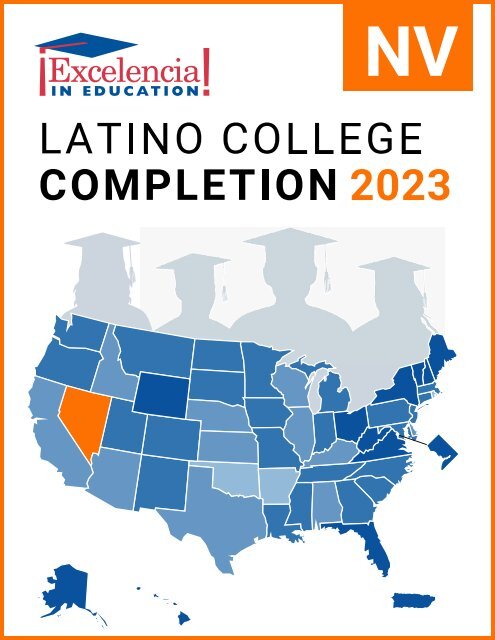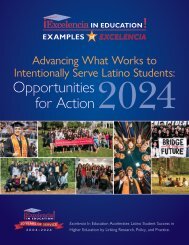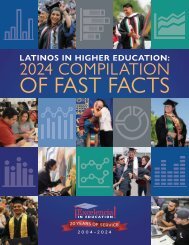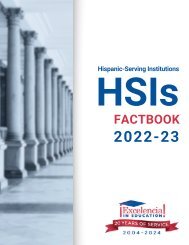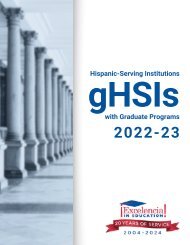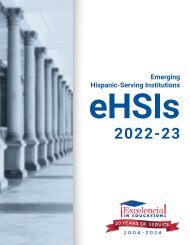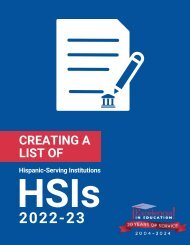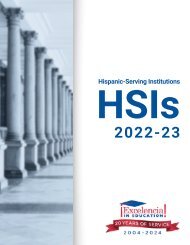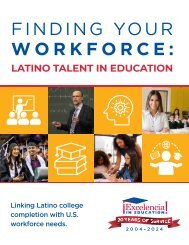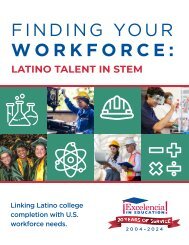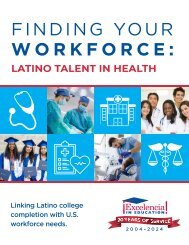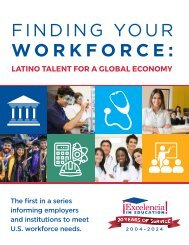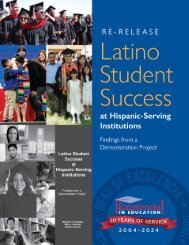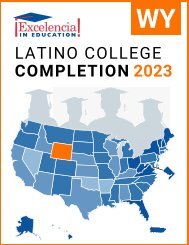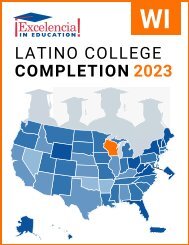Latino College Completion 2023: Nevada
Create successful ePaper yourself
Turn your PDF publications into a flip-book with our unique Google optimized e-Paper software.
NV
LATINO COLLEGE COMPLETION:<br />
NEVADA – <strong>2023</strong><br />
For the U.S. to regain the top ranking in the world for college degree<br />
attainment, <strong>Latino</strong>s will need to earn 6.2 million degrees by 2030. 1<br />
FAST FACTS<br />
STATE RANKING:<br />
<strong>Nevada</strong> had the 14th largest<br />
<strong>Latino</strong> population in the U.S.<br />
K-12 POPULATION:<br />
In <strong>Nevada</strong>, 41% of the K-12<br />
population was <strong>Latino</strong>. 2<br />
POPULATION:<br />
In <strong>Nevada</strong>, 30% of the population<br />
was <strong>Latino</strong>. 2<br />
MEDIAN AGE:<br />
The median age<br />
of Hispanics in<br />
<strong>Nevada</strong> was 29,<br />
compared to 47<br />
for White non-<br />
Hispanics. 2<br />
29<br />
Hispanics<br />
47<br />
White<br />
non-Hispanics<br />
ENROLLMENT:<br />
In <strong>Nevada</strong>, 15% of Hispanics<br />
(ages 18 to 34) were enrolled in higher<br />
education, compared to 19% of<br />
White non-Hispanics. 2<br />
DEGREE ATTAINMENT:<br />
In <strong>Nevada</strong>, 20% of Hispanic<br />
adults (25 and older) had earned an<br />
associate degree or higher, compared to<br />
43% of White non-Hispanic adults. 2<br />
Hispanic Adults = 2.0 of 10<br />
To reach the degree attainment goal by 2030, the U.S. can: close<br />
the degree completion gap by accelerating <strong>Latino</strong> completion while<br />
increasing for all students and scale up programs and initiatives that<br />
work for <strong>Latino</strong>, and all, students. The following demographics,<br />
institutional data, and practices inform <strong>Latino</strong> degree attainment.<br />
ENROLLING: Top 5 Institutions (Hispanic Undergraduates) in <strong>Nevada</strong>, 2021-22<br />
Institution<br />
Sector<br />
Grand<br />
Total<br />
NOTE: We use the terms <strong>Latino</strong> and Hispanic interchangeably in this factsheet.<br />
Hispanic<br />
Total<br />
Source: Excelencia in Education analysis using U.S. Department of Education, National Center for<br />
Education Statistics (NCES), Integrated Postsecondary Education Data System (IPEDS), 2021 Fall<br />
Enrollment, Graduation Rates Survey and Institutional Characteristics Survey.<br />
%<br />
Hispanic<br />
1 <strong>College</strong> of Southern <strong>Nevada</strong> Public, 4-year 27,817 10,725 39%<br />
2 University of <strong>Nevada</strong>-Las Vegas Public, 4-year 24,835 8,303 33%<br />
3 University of <strong>Nevada</strong>-Reno Public, 4-year 16,274 3,853 24%<br />
4 Truckee Meadows Community <strong>College</strong> Public, 4-year 6,307 2,394 38%<br />
5 <strong>Nevada</strong> State <strong>College</strong> Public, 4-year 4,110 1,749 43%<br />
ASSOCIATE DEGREES: Top 5 Institutions Awarding to Hispanics in <strong>Nevada</strong>, 2020-21<br />
Institution<br />
Sector<br />
Grand<br />
Total<br />
Hispanic<br />
Total<br />
%<br />
Hispanic<br />
1 <strong>College</strong> of Southern <strong>Nevada</strong> Public, 4-year 3,323 1,105 33%<br />
2 Truckee Meadows Community <strong>College</strong> Public, 4-year 1,272 377 30%<br />
3 Western <strong>Nevada</strong> <strong>College</strong> Public, 4-year 604 162 27%<br />
4 Great Basin <strong>College</strong> Public, 4-year 339 82 24%<br />
Private forprofit,<br />
2-year<br />
5 Career <strong>College</strong> of Northern <strong>Nevada</strong><br />
93 49 53%<br />
BACHELOR DEGREES: Top 5 Institutions Awarding to Hispanics in <strong>Nevada</strong>, 2020-21<br />
Institution<br />
Sector<br />
Grand<br />
Total<br />
Hispanic<br />
Total<br />
%<br />
Hispanic<br />
1 University of <strong>Nevada</strong>-Las Vegas Public, 4-year 4,823 1,395 29%<br />
2 University of <strong>Nevada</strong>-Reno Public, 4-year 3,730 803 22%<br />
3 <strong>Nevada</strong> State <strong>College</strong> Public, 4-year 761 249 33%<br />
Private not-forprofit,<br />
4-year<br />
4 Roseman University of Health Sciences<br />
287 42 15%<br />
Private forprofit,<br />
4-year<br />
5 Arizona <strong>College</strong> of Nursing-Las Vegas<br />
83 33 40%<br />
White Adults = 4.3 of 10<br />
1 Projections to 2030: Excelencia in Education. (2020). Ensuring America’s Future: Benchmarking <strong>Latino</strong><br />
<strong>College</strong> <strong>Completion</strong> to 2030. Excelencia in Education. Washington, D.C.<br />
2 U.S. Census Bureau, 2021 American Community Survey 1-Year Estimates
<strong>Nevada</strong> Gap in Degree <strong>Completion</strong><br />
Closing the degree completion gap can be tracked<br />
by the 4 measures shown below. Alone, none<br />
of these measures capture the entire “story” of<br />
degree completion. However, in combination,<br />
they provide a useful picture of the gap in degree<br />
attainment between Hispanic and White non-<br />
Hispanic cohorts in a single year.<br />
Graduation Rate — Total percentage of students<br />
who graduated within 150% of normal time for<br />
first-time, full-time freshmen. This incorporates<br />
students that graduated in 3 years at two-year<br />
institutions, or in 6 years at four-year institutions.<br />
Transferred to Another Institution —<br />
Percentage of students that transferred to another<br />
institution and did not complete a degree.<br />
Still Enrolled — Percentage of students that are<br />
still enrolled at the point of 150% normal time to<br />
completion.<br />
No Longer Enrolled — Percentage of students<br />
that are no longer enrolled at the point of 150%<br />
normal time to completion.<br />
At two-year institutions, Hispanics’<br />
graduation rate was 1%-point<br />
higher than that of their White<br />
non-Hispanic peers in <strong>Nevada</strong>.<br />
TWO-YEAR INSTITUTIONS<br />
2%<br />
31%<br />
67%<br />
WHITE<br />
+1%<br />
27%<br />
5%<br />
68%<br />
HISPANIC<br />
DEGREE OUTCOMES<br />
■ No Longer Enrolled<br />
■ Still Enrolled<br />
■ Transferred to<br />
Another Institution<br />
■ Graduation Rate<br />
*Percentages may not add up to 100% due to rounding.<br />
At four-year institutions, Hispanics’<br />
graduation rate was 10%-points<br />
lower than that of their White<br />
non-Hispanic peers in <strong>Nevada</strong>.<br />
FOUR-YEAR INSTITUTIONS<br />
38%<br />
7%<br />
6%<br />
50%<br />
WHITE<br />
-10%<br />
43%<br />
12%<br />
5%<br />
40%<br />
HISPANIC<br />
NOTE: Outcomes shown are for students at two-year institutions who started in Fall 2018, and<br />
for students at four-year institutions who started in Fall 2015.<br />
Source: Excelencia in Education analysis using the U.S. Department of Education, National<br />
Center for Education Statistics (NCES), Integrated Postsecondary Education Data System, 2021<br />
Graduation Rates Survey and the Institutional Characteristics Survey.<br />
Examples of What Works for <strong>Latino</strong> Students<br />
There are institutions showing success in enrolling, retaining, and graduating <strong>Latino</strong> students. The following are examples of<br />
programs across the country with evidence of effectiveness in serving <strong>Latino</strong> students nominated for Examples of Excelencia.<br />
The Mathematical and Theoretical Biology Institute (MTBI)<br />
is embedded in Arizona State University’s (ASU) Simon A. Levin<br />
Mathematical, Computational, and Modeling Sciences Center to<br />
connect the center’s education-through-research mission directly<br />
to trans-disciplinary undergraduate and graduate programs in the<br />
mathematical sciences. MTBI seeks to recruit students to careers in the<br />
mathematical sciences by providing an intensive research experience<br />
of student-driven research where participants actively contribute to<br />
setting the research agenda. MTBI hosts a summer research program,<br />
encouraging and facilitating access and completion of a graduate<br />
studies degree in mathematics and science. A collaborative learning<br />
environment and community among students and faculty aids students<br />
in their research and provides a source of support in graduate school<br />
and beyond. MTBI gives students an insight into what to expect in the<br />
pursuit of a Ph.D. and aims to strengthen and diversify the pool of<br />
U.S. students pursuing graduate degrees in math and sciences. Alumni<br />
progress is monitored for at least six years after participation to<br />
provide support, community, and measure program success.<br />
From 1996 through 2016, MTBI has recruited and enrolled 533 students,<br />
70% of them are underrepresented minorities, and approximately half of<br />
them identified as <strong>Latino</strong>. Through February 2017, 71% of MTBI students<br />
enrolled in graduate or professional school programs. 108 MTBI students<br />
have completed their Ph.D. and 67 of those students were Hispanic/<strong>Latino</strong>.<br />
For more information on institutional programs improving <strong>Latino</strong> student success in higher education, access Excelencia in<br />
Education’s Growing What Works database at http://www.edexcelencia.org/growing-what-works<br />
ENSURING AMERICA’S FUTURE BY INCREASING LATINO COLLEGE COMPLETION • WWW.EDEXCELENCIA.ORG


